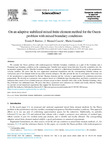Mostrar o rexistro simple do ítem
On an adaptive stabilized mixed finite element method for the Oseen problem with mixed boundary conditions
| dc.contributor.author | Barrios, Tomás P. | |
| dc.contributor.author | Cascón, J. Manuel | |
| dc.contributor.author | González Taboada, María | |
| dc.date.accessioned | 2020-04-23T14:36:20Z | |
| dc.date.available | 2020-04-23T14:36:20Z | |
| dc.date.issued | 2020-06-15 | |
| dc.identifier.citation | Tomás P. Barrios, J. Manuel Cascón, María González, On an adaptive stabilized mixed finite element method for the Oseen problem with mixed boundary conditions, Computer Methods in Applied Mechanics and Engineering, Volume 365, 2020, 113007, ISSN 0045-7825, https://doi.org/10.1016/j.cma.2020.113007. | es_ES |
| dc.identifier.issn | 0045-7825 | |
| dc.identifier.uri | http://hdl.handle.net/2183/25419 | |
| dc.description.abstract | [Abstract] We consider the Oseen problem with nonhomogeneous Dirichlet boundary conditions on a part of the boundary and a Neumann type boundary condition on the remaining part. Suitable least squares terms that arise from the constitutive law, the momentum equation and the Dirichlet boundary condition are added to a dual-mixed formulation based on the pseudostress-velocity variables. We prove that the new augmented variational formulation and the corresponding Galerkin scheme are well-posed, and a Céa estimate holds for any finite element subspaces. We also provide the rate of convergence when each row of the pseudostress is approximated by Raviart–Thomas elements and the velocity is approximated by continuous piecewise polynomials. We develop an a posteriori error analysis based on a Helmholtz-type decomposition, and derive a posteriori error indicators that consist of two residual terms per element except on those elements with a side on the Dirichlet boundary, where they both have two additional terms. We prove that these a posteriori error indicators are reliable and locally efficient. Finally, we provide several numerical experiments that support the theoretical results. | es_ES |
| dc.description.sponsorship | Xunta de Galicia; ED431G 2019/01 | es_ES |
| dc.description.sponsorship | Universidad Católica de la Santísima Concepción (Chile); 1160578 | es_ES |
| dc.description.sponsorship | Ministerio de Economía y Competitividad; MTM2016-76497-R | es_ES |
| dc.description.sponsorship | Ministerio de Ciencia, Innovación y Universidades; PRX19/00475 | es_ES |
| dc.description.sponsorship | Xunta de Galicia; GRC ED431C 2018-033 | es_ES |
| dc.language.iso | eng | es_ES |
| dc.publisher | Elsevier BV | es_ES |
| dc.relation.uri | https://doi.org/10.1016/j.cma.2020.113007 | es_ES |
| dc.rights | Atribución-NoComercial-SinDerivadas 4.0 España | es_ES |
| dc.rights.uri | http://creativecommons.org/licenses/by-nc-nd/4.0/ | |
| dc.subject | Oseen | es_ES |
| dc.subject | Mixed finite element | es_ES |
| dc.subject | Stabilization | es_ES |
| dc.subject | A posteriori error estimates | es_ES |
| dc.title | On an adaptive stabilized mixed finite element method for the Oseen problem with mixed boundary conditions | es_ES |
| dc.type | info:eu-repo/semantics/article | es_ES |
| dc.rights.access | info:eu-repo/semantics/openAccess | es_ES |
| UDC.journalTitle | Computer Methods in Applied Mechanics and Engineering | es_ES |
| UDC.volume | 365 | es_ES |
| dc.identifier.doi | 10.1016/j.cma.2020.113007 |
Ficheiros no ítem
Este ítem aparece na(s) seguinte(s) colección(s)
-
GI-M2NICA - Artigos [74]






